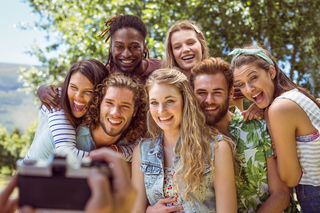Friends
How a Picture With Friends Can Get You a Date!
Can friends (or lovers) make you more attractive to others?
Posted September 30, 2017

Over the years, I have offered a lot of tips about attraction. For example, whether in an online dating picture or face-to-face, I have shared which type of body language is attractive. I have also discussed how particular ways of grooming, dressing, and looking are important for attraction in photos, and in person. Once people are interacting more, I have explored how playing hard to get may increase attraction in certain contexts, too.
All of these effects primarily rely on just the two people interacting, though. What about the friends, associates, and lovers already in our social life? What impact do they have on our dating and mating? After all, previous research suggests that men having fun with friends makes them stand out to women and getting fixed up through friends is often a main way people find love.
To address this question, I dove into the research literature and came up with an interesting answer. Particularly, I found that we humans do use information from the behavior of others (called social learning) to select mates of our own. This process is generally known as mate choice copying.
Little, Caldwell, Jones, and DeBruine (2011) published a series of studies evaluating the effects of mate choice copying in humans. Specifically, they wanted to explore the various ways that being paired in pictures with other people impacted how attractive a person appeared to study participants. The group was particularly interested in examining how social learning impacted the mate preference of those participants.
In their first study, Little, Caldwell, Jones, and DeBruine (2011) asked participants to look at pairs of facial pictures on a computer screen. The faces were of opposite-sex pairs and of different levels of attractiveness. Participants were then asked to rate the attractiveness of the pictures of the individuals of their opposite sex, as a potential mate. Results indicated that participants were more attracted to pictures of those potential mates when they were paired with attractive pictures of someone of the opposite sex. In other words, female participants found male pictures more attractive when the males were paired with other pictures of attractive women. Similarly, male participants found female pictures more attractive when they were paired with other pictures of attractive men.
In the second study, Little, Caldwell, Jones, and DeBruine (2011) repeated the procedure, but asked participants to rate the faces of the same sex as themselves. In this context, there was no difference in ratings due to the attractiveness of the paired pictures.
There was a difference in the third study, when same-sex paired pictures were used. In this context, participants found pictures of potential mates less attractive when paired with attractive same-sex friends.
Therefore, for both men and women, being associated with better-looking people of the same sex made them look less attractive by comparison.
In the final study, the researchers paired pictures of individuals with attractive or unattractive non-face stimuli (flowers or thorns). In this case, participants showed a slight effect of viewing potential mates as less attractive when paired with flowers, as opposed to thorns. This effect was primarily seen for already attractive faces, though.
Overall, given these results, it appears that social learning does play a role in our dating and mating preferences. Who we surround ourselves with can make us look more (or less) attractive in different contexts. Particularly, being associated with someone attractive of the opposite sex can make someone look more attractive to potential mates, too (i.e., mate choice copying). However, being associated with someone attractive from the same sex can make someone look less attractive to potential mates as well (a downward comparison).
Picturing Your Friends Well
The results indicate that who we choose as friends does provide others with information about us as potential mates. In some ways, we are measured and evaluated by those around us. Therefore, who we pick as friends (and who we choose to be pictured with) can have an impact on who picks us as lovers, as well. The effects may be especially prominent when you go out or when you arrange online profile photos:
- If you include someone of the opposite sex as yourself (and the same sex as your desired partner), it may benefit you if they happen to be attractive. Potential mates will see them with you and infer that you are attractive as a partner (again, an example of mate choice copying).
- If you include someone of the same sex as yourself, it may benefit you if they are less attractive than you are. Potential mates could compare you both as partners and potentially see you as the more attractive choice.
Again, these comparisons can be particularly helpful for those who are trying to find a date or mate online. Beyond that, having attractive body language and looking your best are still important. After you “swipe and match” (or meet through friends), sharing your attractive personality and highlighting your unique features becomes essential.
Make sure you get the next article: Click here to sign up to my Facebook page. Remember to share, like, tweet, and comment below too.
© 2017 by Jeremy S. Nicholson, M.A., M.S.W., Ph.D. All rights reserved.
References
Little, A. C., Caldwell, C. A., Jones, B. C., & DeBruine, L. M. (2011). Effects of partner beauty on opposite-sex attractiveness judgments. Archives of Sexual Behavior, 40, 1119-1127.




